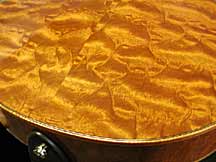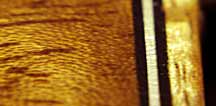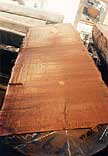MAHOGANIES
HOME ORDER ONLINE PRODUCTS REGISTER CONTACT US
Honduran Mahogany Click on Part ID to add to shopping cart More info below
PART No. Description Price Ea. 6 - 12 13 - 24 25+ Honduran mahog. backs, Dread - 9" width $43.00
$41.00
$38.00
$32.00
Honduran mahog. sides, Dread - 5" wide $43.00
$41.00
$38.00
$32.00
Honduran mahog. backs, OM - 8" width $38.00
$36.00
$34.00
$28.00
Honduran mahog. sides, OM - 4.5" wide $38.00
$36.00
$34.00
$28.00
for All Mahogany


Mahogany outlook for the future. 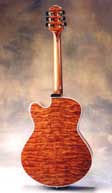
Ribbecke arched guitar of quilted (Genuine) mahogany.

Older Genuine mahogany with homogeneous grain—unusual these days.
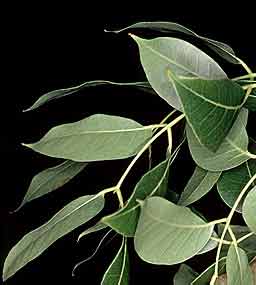
Genuine mahogany is also known as Bigleaf mahogany.
African mahogany (Sapele in this case) shows the characteristic stripe in the example below. Not a true mahogany, but very good for guitar backs and sides—generally harder and heavier than Honduran.
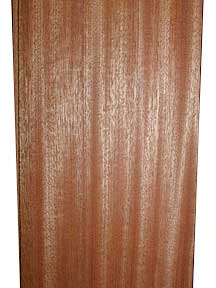
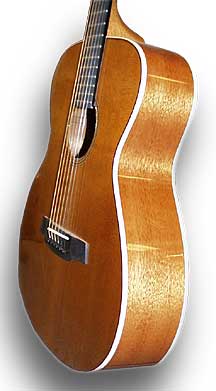
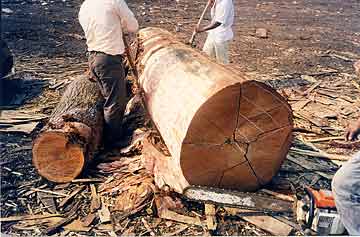
Genuine mahogany, Swietenia macrophylla log being maneuvered and marked for resawing.
Genuine mahogany, also known as Honduran or Bigleaf mahogany grows from Mexico south to Brazil. It's one of three species of genuine mahogany, but the only one that's really commercially available. It is on the WWF list of 10 most endangered species and is on appendix II of the Cites Treaty, and requires CITES documentation when shipping out of the U.S. Most of the mahogany came out of Brasil in the last 30 years or so, but these days, much comes from Peru as well as several of the Central American countries. Although still available it is getting increasingly difficult to obtain, and maintaining quality is just as difficult.

Above, mahogany log being resawn at the mill in Central America.
We will occasionally have quilted and figured mahogany, but it is rare, and it will never be a stock item.
As of this writing (late November 2001) there is a mahogany shortage in the States, partly due to the unstable political situation in Peru, and Brasil placed an embargo on exporting mahogany because of over exploitation. This has been of more concern for neck woods than for backs and sides, and many who have relied on straight-grained 12/4 slab-sawn planks for raw material are devising other methods of neck construction to take this into account.
Below, mahogany back set, left panel was on top and exposed to sun for a few months.

Lower right, my Martin D-18 with characteristic "red" mahogany back and sides. Martin pore fills with dark filler before finishing. Left, CFOX guitar of mahogany with clear pore filler. Below, more recent Ribbecke quilted mahogany archback guitar with detail of goldleaf purfling.

Tom Ribbecke steel string of quilted mahogany. We had about 30 sets of the amazing mahogany when both Tom and I were at Luthiers Mercantile in the late 80s. I've seen other quilted mahogany, but never anything like this material which was quilted on all faces of the planks, which we later resawed.
Below, mahogany log, just halved.
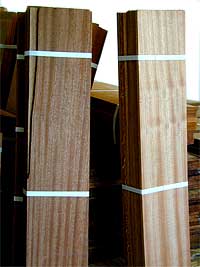
Side sets of Sapele bundled for shipment. The sets on the left have oxidized from exposure to the sun.
Both Old and New World mahoganies are considered to be very good for guitar backs and sides, particularly for recording instruments. Feedback and other audio problems that often plague guitars of rosewood are rarely encountered with mahogany-backed guitars.
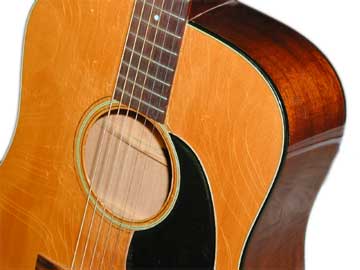
When bending mahogany sides less water is better than more. Avoid sides with wood of varying densities as they tend to "bubble."
Address General Information
Sales/support Telephone:
707-431-3760 POB 217, 101 C Grant Avenue, Healdsburg, Ca. 95448 USA info@alliedlutherie.com sales@alliedlutherie.com Fax:
707-431-3762 
.
